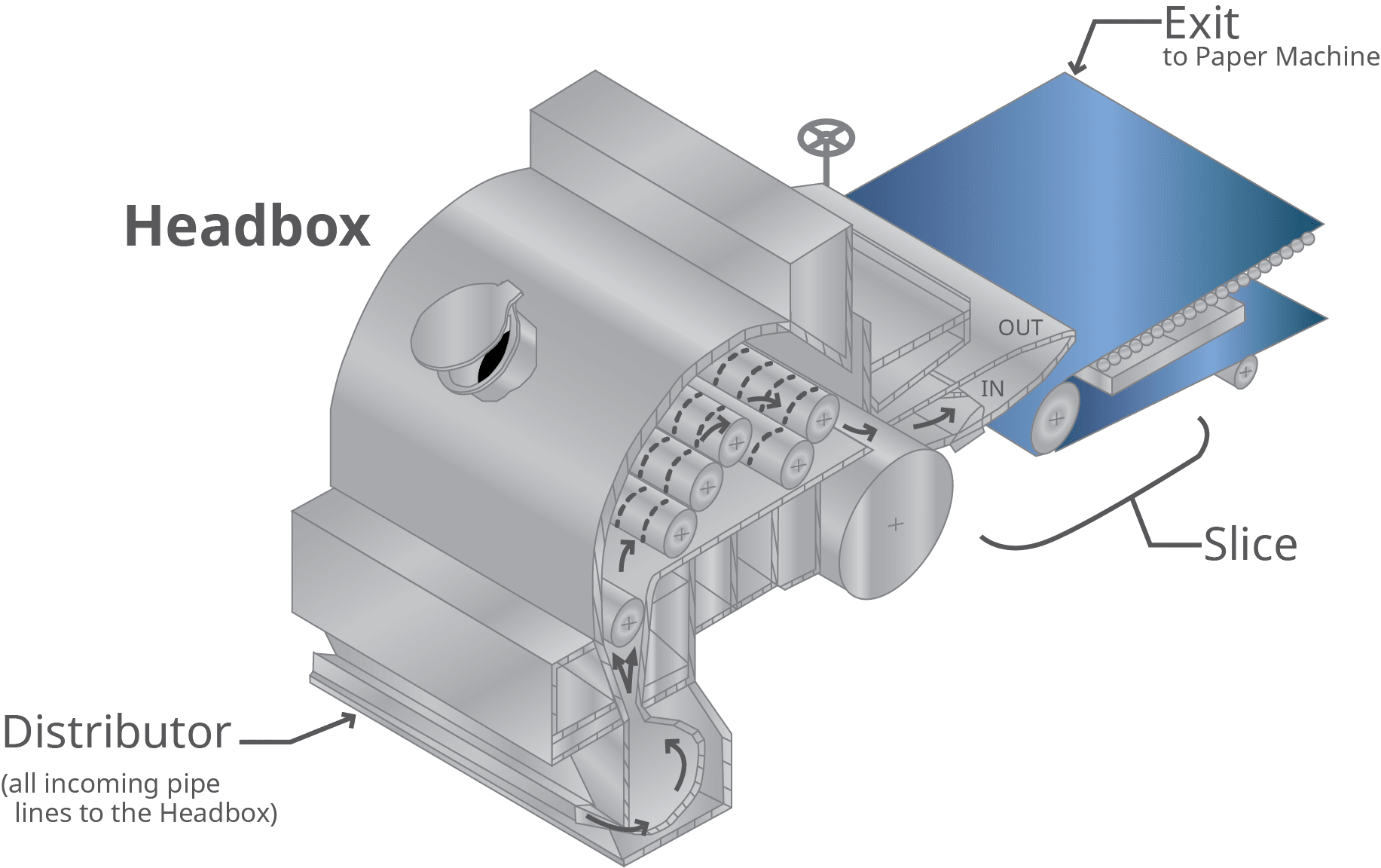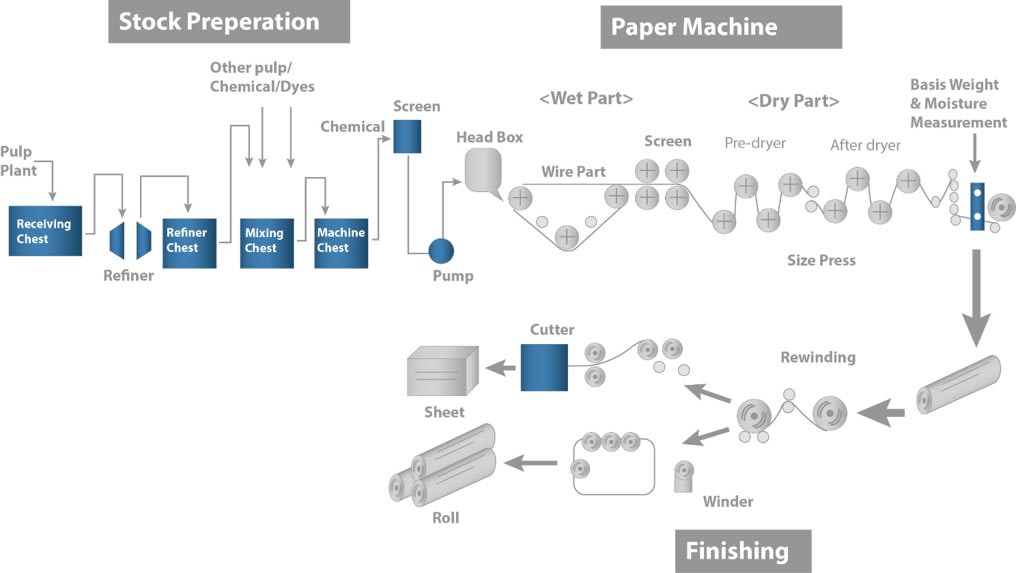Effective Measurement and Control of pH at the Headbox
Industry: Pulp and Paper
Product: pH Process Liquid Analyzers
Introduction
Problems at the wet end of a paper machine can rarely be corrected downstream. That is why monitoring and controlling pH in pulp stock is critical to the paper-making process. Essentially, at every stage in the manufacture of paper, correct pH values play a vital role. Variations in the pH value at the headbox adversely affect the quality of the paper produced.
Process Overview
The headbox physically prepares the pulp stock before it is converted into paper by the papermaking machine. It does so by smoothing out any outstanding variability in the pulp flow. 
The front section of the headbox, called the stock distributor, receives the pulp stock flow from one or more inlet pipes and spreads it uniformly to a width equal to the final paper width. The central portion of the headbox dampens excessive pulp stock flow turbulence from inlet cross flows from the stock distributor, corrects flow inequalities, and directs the stock into the slice (rear portion of headbox). The slice, which is located at the back of the headbox, controls the distribution of pulp stock onto the papermaking machine. The stock flows between a stationary lip and a movable lip to ensure an even velocity across the width of the machine to provide a constant, random fiber distribution.
Solution
The incoming wet stock to the headbox has a higher pH than desired and must be reduced. The pH of the pulp stock does not affect the final product quality as dramatically as it does in the bleaching process, but it is still important in achieving the desired printability of the paper. The stock is commonly controlled around 4.5 pH by adding alum or sulfuric acid upstream of the headbox; however, the pH may be adjusted and controlled at whichever value is required to obtain optimum overall results.
Effective measurement and control of pH at the headbox requires equipment that can stand up to the abrasive components of the stock pulp. The headbox is the first wet end component of the paper machine and has high levels of suspended solids, which make the pH measurement difficult because sensors are prone to plugging and fouling. Those result in cleaning, calibration, and, possibly, replacement of electrodes.
Field Data
The headbox is the final location where pH control can alter the pulp stock before it reaches the paper machine. Therefore, it is very important to have an accurate, reliable, and continuous pH measurement.
Product Recommendations
Yokogawa has extensive experience dealing with the plugging and fouling problems that occur with pH measurements in paper mills. This has led to the selection of the model PH97/DP sensor, which has a solid-state reference that is resistant to plugging and fouling. The PH97 is designed as a replaceable 4-1 sensor used in conjunction with the model PH87 retractable assembly. The PH97 includes a glass pH electrode, a solid-state reference electrode, solution ground, and a Pt 1000 temperature element. All these components are sealed in a rugged RytonTM body.
The model PH87 assemblies are constructed of chemically resistant titanium and include blowout safety protection utilizing a flared tip design, which provides a metal-to-metal stop during retraction. Integral junction boxes are provided for simple installation and wiring. The retractable assembly is suitable for removal from a process line or vessel at pressures up to 70 PSI (482.65 kPa) without interrupting the flow or draining the tank. The PH87 comes in different lengths to simplify proper insertion in the process line or tank.
Another alternative Yokogawa offers is the model PH18 differential pH sensor that is constructed of an enamel-coated steel rod. The PH18 consists of a pH-sensitive enamel and a sodium ion enamel combined with an integral temperature element to form a probe without internal solutions. Therefore, the PH18 contains no reference electrode or junction that could become plugged or give way to fouling. Once it is installed and calibrated, this sensor requires very little maintenance.
Measurement System
Process Liquid Analyzer:
- 2-wire FLEXA202 pH/ORP Analyzer
- 4-wire FLXA402 pH/ORP Analyzer
Sensor Selection:
Option 1: PH18 Differential pH Electrode

Option 2:
Holder: PH87/B Retractable Assembly
Sensor: PH97/DP pH Electrode

Note: For additional information on this application, please contact Yokogawa.
Key Advantages
- The model PH87 provides effective measurement and control of pH.
- Accurate, reliable, and continuous pH measurement contributes to equipment sustainability.
- Proper monitoring ensures minimizing plugging and fouling problems that occur with pH measurements in paper mills.
- Minimized maintenance requirements for cleaning, calibration, and replacement of electrodes result in fewer production disruptions.
Industrias
-
Papel y pulpa
La industria del papel y la pulpa es altamente competitiva y debe satisfacer necesidades del mercado que están en constante cambio. Yokogawa ayuda a poner en operación plantas eficientes en el consumo de energía que son sostenibles globalmente.
Productos y Soluciones Relacionadas
-
Digital SMART SENCOM™ Adapter, SA11
Reusable SMART adapter, requiring only the analog sensor to be disposed of when it reaches the end of its lifetime. With the SENCOM 4.0 platform, Yokogawa delivers reduced costs and waste while contributing to its long-term business goals of a sustainable future for all.
¿Tiene Dudas?
Contacte a un Experto de Yokogawa y conozca como podemos ayudarle a resolver sus retos.